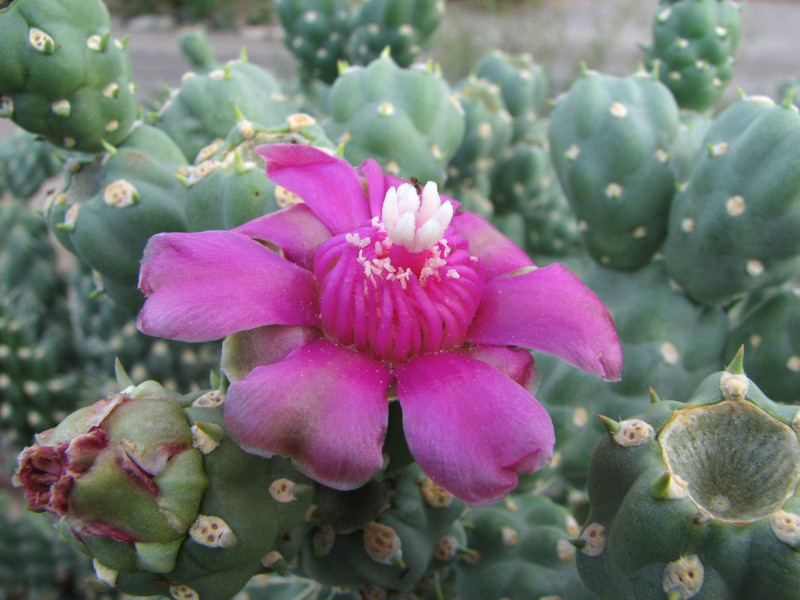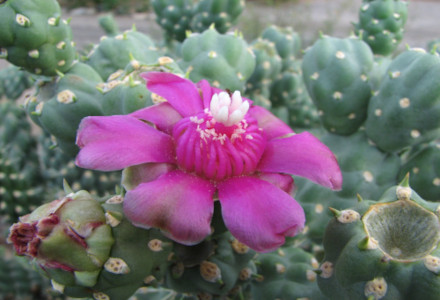
Jumping Cholla Facts
- The intriguing term of Jumping Cholla represents the most frequently used common name for a remarkable variety of Angiosperm. It does, however, have at least one other broadly accepted general title. That’s the descriptive hanging chain cholla.
- Within the scientific community, though, it’s perhaps better known by its technical designation. Unfortunately, that’s an extremely difficult one for the layperson to pronounce. That’s because it holds the formal tag of Cylindropuntia fulgida.
- The remarkable plant received that moniker due to the efforts of George Engelmann. The respected German-American botanist accomplished the first recognition of it as a separate and distinct species. He managed that noteworthy feat in the late 1850’s.
- Fortunately, the impressive Jumping Cholla appears to be maintaining a population base that’s both stable and sufficient. That pleasant state also seems to hold true throughout its native range. The IUCN thus currently lists the species as Least Concern.
- The marvel of Nature nevertheless should be considered as facing at least several potential threats to its continued existence. Many of these stem from the actions of mankind. They include the related dangers of habitat loss and ongoing climate change.
Related Articles
Jumping Cholla Physical Description
The intriguingly named Jumping Cholla easily captures the attention and imagination of those who encounter it. That holds especially true in the wild. Yet, it typically does so due to its appearance more than size. That’s true since it’s not an overly large plant.
What the flora lacks in size, it makes up for in distinctiveness, though. As a general principle, mature specimens attain heights measuring approximately 13 ft (4 m). This sometimes varies, however, most often due to various locally present environmental conditions.
Each individual generally produces a single trunk. In color, this portion of the plant usually presents as a light to dark brown. It also boasts an impressive covering of groupings of long, extremely sharp spines. These features also appear along the entirety of its length.
The trunk also most often begins to branch widely in close proximity to the ground. Each branch protruding from this presents the roughly cylindrical shape and waxy flaky texture common to most cacti. These branches also display the dense covering of grouped spines.
Like its kindred around the world, the Jumping Cholla does not possess leaves. The many spines it displays replace those. Each of these usually ranges in length from roughly 0.75 – 1.18 in (2 – 3 cm). These show a silvery-yellow when young, changing to gray with age.
The plant also produces stunning flowers when it blooms. In color, they display a gorgeous blend of mainly white and pink. Yet, streaks of lavendar also occur. The flowers measure about 1 in (2.5 cm) in width, and appear at the tips of the joints of the plant.
- Kingdom: Plantae
- Phylum: Tracheophytes
- Class: Eudicots
- Order: Caryophyllales
- Family: Cactaceae
- Genus: Cylindropuntia
- Species: C. fulgida
Jumping Cholla Distribution, Habitat, and Ecology
The amazing Jumping Cholla evolved as endemic to a moderately small swathe of the earth’s surface. The nature of at least part of that native zone of habitation likely won’t surprise many people, though. That’s due to the fact that it developed as native to North America.
But, inside of that greater territory, it only appears in a very limited section. This area, in fact, crosses the borders of Mexico and the United States. In Mexico, it mainly lives in the state of Sonora. In the United States, it primarily appears in the state of Arizona.
It also lives it small, scattered populations in Nevada, Colorado, and Utah. It’s unknown if it ever had a greater range. In all regions it calls home, however, it displays decidedly strong preferences regarding its choice of habitat. These follow patterns common to its kind.
That’s because the flora lives almost exclusively in climate consisting of hot, arid or semi-arid rangeland. It also makes its presence noted in subtropical areas. Altitude plays a role as well. The plant only dwells at known heights ranging from 980 – 3,280 ft (300 – 1,000 m).
Much like its many relatives across the globe, the Jumping Cholla reproduces via two separate methods. It produces seeds, attached to the stems. These features break off at the slightest touch of a passing animal, including humans. These later fall off, to attempt growth.
This rarely succeeds, though, since most stems lack seeds. The majority of reproduction therefore occurs through the other method. As stems break off, each has the ability to begin a new plant where it falls. This vegetative process thus serves as its major of spreading.
Nevertheless, the few seeds produced do sometimes attribute to the creation of new plants via other means of spreading. Birds often feed on the fruit, to later spread the seeds in their droppings. Strong desert winds also occasionally break off fruits, creating the same result.
Species Sharing Its Range
Check out our other articles on 5 Remarkable United States Reptiles, Eurasian Brown Bear, Le Morne Brabant, Southern Darwin’s Frog, East African Lowland Honey Bee

